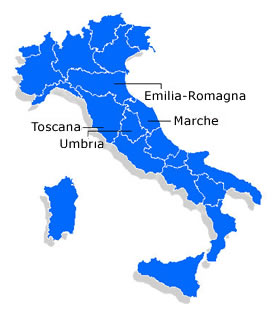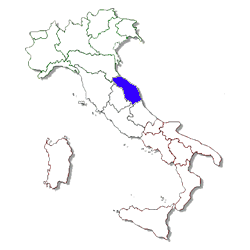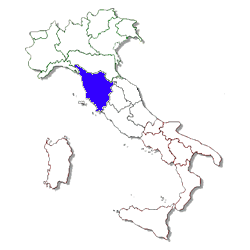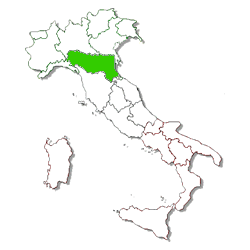|
 The Food of Central Italy The Food of Central Italy
In Central Italy the summers are warmer and the days are longer than those of Northern Italy. Due to the difference in temperature tomato based recipes are more common. A tomato plant needs eight to 12 hours a day of full sun. This is why tomatoes are readily available.
The other common food staple is meats and stews which consists of mixed grilled or roasted meats that includes chicken, pork, lamb and beef. There is a strong farming community and tradition.
Saffron is a common herb grown that gives a completely distinctive flavor to most dishes. Chestnuts are also a common part of the diet thanks to the hilly areas. Chestnuts in Central Italy were in the past one of the staple foods of the poor and even now roasted chestnuts are a wonderful treat in winter, as are the dishes made with fresh chestnut flour.
Historical patterns still reflect in regional diets. As the national capital, Rome serves as an intermediary between north and south in political as well as culinary matters. Abruzzi and Molise show a southern touch in dishes that are decisively piquant. The Marches shares recipes with central neighbors, as well as Emilia-Romagna to the north. Tuscany and Umbria have tastes in common, though throughout the heartland cooks uphold traditions in local ways.
The Romans also introduced culinary ideas to other lands. From earliest times, the Greeks thought of the Romans as a wine-producing nation and learned from them wine fermentation and processing techniques as well as the drinking of wine diluted with water and often sweetened with honey. Most of the world had been content to dine on spit-roasted meats, but the Romans seem to have introduced the notion of boiling and stewing in kettles. Various boiled greens (many considered weeds today) were commonly used in many lands, but the Romans brought with them the conviction that cabbage was worth cultivating since it contained medicinal properties. In fact, Europe took the Romans word that oysters were delicious and even set about cultivating them in many lands. Similarly, edible snails were introduced to European palates by the Romans and remain a French favorite today.
If you have information on Central Italy that you would like to share with us, please fill out our online contact form and it will be our pleasure to respond as soon as possible.
Le Marche - Central Italy
|
| |
 Le Marche - Central Italy Le Marche - Central Italy
Le Marche is a self sufficient area. It is known for its Adriatic seafood, used to produce local versions of the rich fish stew, brodetto. The local cuisine also makes use of its white and black truffles, wild mushrooms and fennel. Ramed dishes include porchetta (roast pig) & vincigrassi which is lasagna made with chicken livers and prosciutto. Pasta, notably maccheroncini and tagliatelle, has an important tradition in Marche. Pastificio Latini produces some of the best artisanal pasta in the Marche tradition. Mushrooms grow in abundance in this area. Three kinds of truffles are also found in Marche; the white ones rival those from Alba. Cauliflowers from the Marches are famous throughout Italy. And the fruit--apples, peaches, figs and cherries-- are rich and luscious, a testament to the fertility of the soil. Bordered by Umbria on one side and the Adriatic Sea on the other, Marche is partly mountainous, with land sloping from the mountains right down to the sea. Tourists flock to Marche's straight, smooth, sandy beaches, but the region's interior goes largely ignored. The Adriatic offers an outstanding variety of blue fish and crustaceans, some of which are rare and can only be found on this coast.
For more information on Le Marche click here →
|
|
| |
 Tuscany - Central Italy Tuscany - Central Italy
Tuscan cooking is renowned as some of the simplest in Italy. The finest extra virgin oils are made there. Meals are centered around meat, especially beef. Tuscany's wines are exceptional with Chianti being Italy's most famous red. Tuscans keep fat at a distance and the spit or the grill close by. Meats--beef, chicken, and rabbit--are usually roasted with rosemary or fennel or grilled. Most are accompanied by a lemon wedge, the Tuscan idea of a sauce. Along the coast, dishes are based on fish, with baby eel, caught at the mouth of the Arno, a specialty found only in Tuscany. Olive oil is so pervasive in Tuscan cooking that it's even used in sweets, such as the local favorite, castagnaccio, a cake made with chestnut flour, fennel, raisins, and pine nuts. Generally, desserts are as simple as Tuscans' other foods. A common after-dinner treat is biscotti dipped into a glass of amber-colored Vin Santo. Siena is home to panforte ("strong bread"), a rich, flat cake invented during the Crusades to sustain the troops.
Tuscan wines are dominated by the local sangiovese grape, the backbone of the classic Chianti and full, deep Brunello. Toscana, region (approximately 3,712,677), 8,876 sq mi (22,989 sq km), N central Italy, bordering on the Tyrrhenian Sea in the west and including the Tuscan Archipelago. Toscana, famous for its art, architecture, rolling hills, and smooth beaches, is the cradle of the Renaissance. It is this popular destination that gave us da Vinci, Michelangelo, and Puccini. It's no surprise then that Toscana is the birthplace of Italy's most creative and elegant cuisine.
For more information on Tuscany click here →
|
|
| |
 Umbria - Central Italy Umbria - Central Italy
Umbrian food is hearty and simple. It is most famous for its use of pork. It is home also of the great pecorino cheeses. Umbrian dishes rarely contain more than four or five ingredients, and meats and vegetables are often served plain or sauceless. Meat is important to this region, and it is here that salami is at its best. Pork products, salami, sausages, cured and smoked meat appear on every restaurant's antipasto cart. Beef is also good, especially when it comes from cattle bred near the Tuscan border. As Umbria is landlocked, fresh-water fish--carp, pike and eel--are an important part of the region's cuisine.
Olive oil is the region's condiment of choice. Pasta tends to be long and thick and is often flavored with a grating of its world-famous black truffles, which are used liberally on everything from polenta to potatoes. Perugia, the region's capital, is renowned around the world for its chocolate. Perugina, makers of Baci, is based here. Desserts are often flavored with honey, chestnuts, pine nuts, hazelnuts and almonds.
Although not a large wine-growing region, Umbria produces the light, dry Orvieto, a favorite among princes and popes, and the wine for which the region is famous. This plentiful region also produces a fine red, Montefalco Rosso. At the center of Italy is a tiny, unspoiled area, a land of brilliant green mountains and hills and dazzling blue lakes and rivers. Often described as "enchanted," Umbria is full of abbeys, monasteries, and convents. Umbrian dishes rarely contain more than four or five ingredients, and meats and vegetables are often served plain or without sauce. Meat is important to this region, and it is here that salami is at its best. Pork products--salami, sausages, cured and smoked meat--appear on every restaurant's antipasto cart. Beef is also good, especially when it comes from cattle bred near the Tuscan border.
For more information on Umbria click here →
|
Emilia Romagna - Central Italy
|
| |
 Emilia Romagna - Central Italy Emilia Romagna - Central Italy
Emilia Romagna known as the Italy's greatest region for food. Emilia Romagna is the mother land of homemade pasta. In Bologna, tagliatelle, lasagne, and tortellini are favorites. In Emilia, preparing pasta is a work of art. Pork is a tradition of Emilia-Romagna's cuisine. Prosciutto, the most famous of Italy's pork products, is made in Parma. Coppa and pancetta are specialties of Piacenza in the north. The delicate meat that is often passed off in other countries as bologna is in fact the famed Mortadella of Bologna. Romagna has a tradition of fish dishes, brodetto, the most flavorful of fish soups. Parmigiano Reggiano, the unrivaled king of cheese.Another of Emilia-Romagna's great culinary contributions is balsamic vinegar, which has been made in Modena for centuries.Prosciutto di Parma is produced south of Parma and often served very thin with bread. Parmiggiano Reggiano is eaten in chunks or grated over a wonderful fresh egg pasta.Home of homemade pasta, prosciutto and parmigiano. Emilia-Romagna is the motherland of homemade pasta. In Bologna, tagliatelle, lasagne, and tortellini are favorites. In Emilia, preparing pasta is second nature and like an artform to watch. Pork is a tradition of Emilia-Romagna's cuisine. Prosciutto, the most famous of Italy's pork products, is made in Parma. Coppa and pancetta are specialties of Piacenza in the north.
For more information on Emilia Romagna click here →
|
Home | Advertising Information | Contact Us
Copyright ©2002 Italian Recipes Trinakria Development. All rights
reserved. |
 |
 |
|

 The Food of Central Italy
The Food of Central Italy Le Marche - Central Italy
Le Marche - Central Italy Tuscany - Central Italy
Tuscany - Central Italy Umbria - Central Italy
Umbria - Central Italy Emilia Romagna - Central Italy
Emilia Romagna - Central Italy